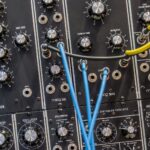Support our educational content for free when you purchase through links on our site. Learn more
What Makes a Song Synth-Pop? 10 Essential Elements to Know! 🎶
Have you ever found yourself bobbing your head to a catchy tune, only to wonder what exactly makes it synth-pop? You’re not alone! Synth-pop has a magnetic allure that draws listeners in with its infectious melodies and electronic soundscapes. From the pulsating beats of Depeche Mode to the dreamy synths of The Human League, this genre has left an indelible mark on the music scene since its inception.
In this article, we’ll dive deep into the 10 essential elements that define synth-pop, exploring everything from its iconic instruments to its cultural impact. Did you know that synth-pop was born out of a blend of progressive rock and disco? Or that it paved the way for modern pop icons like Dua Lipa and The Weeknd? Buckle up, because we’re about to take you on a journey through the vibrant world of synth-pop, revealing the secrets behind its irresistible charm!
Key Takeaways
- Synth-Pop Origins: Emerged in the late 1970s, influenced by progressive rock and disco.
- Signature Sound: Characterized by catchy melodies, synthesizers, and drum machines.
- Cultural Impact: Shaped fashion, film, and modern music, influencing artists across genres.
- Iconic Artists: Key figures include Kraftwerk, Depeche Mode, and The Human League.
- Modern Revival: Continues to evolve, inspiring new generations of musicians.
If you’re ready to explore the world of synthesizers, check out our recommended links for the best synthesizers and drum machines to kickstart your synth-pop journey! 🎹
Table of Contents
- Quick Tips and Facts About Synth-Pop 🎹
- The Evolution of Synth-Pop: A Musical Journey 🎶
- Defining Characteristics of Synth-Pop Hits ✨
- Synth-Pop’s Iconic Sound: Instruments and Techniques 🎧
- The Cultural Impact of Synth-Pop: From the ’80s to Today 🌍
- Criticism and Controversies Surrounding Synth-Pop ❌
- Influence and Legacy: How Synth-Pop Shaped Modern Music 🎤
- Notable Synth-Pop Artists You Should Know 🎤
- Synth-Pop in the Digital Age: Trends and Innovations 💻
- Synth-Pop vs. Other Genres: What Sets It Apart? ⚡
- Conclusion: The Enduring Allure of Synth-Pop 🎉
- Recommended Links for Synth-Pop Enthusiasts 🔗
- FAQ: Your Synth-Pop Questions Answered ❓
- Reference Links for Further Reading 📚
1. Quick Tips and Facts About Synth-Pop 🎹
Want to get the lowdown on synth-pop fast? Here’s your cheat sheet!
- Birthplace: Late 1970s UK and Germany (though Japan’s Yellow Magic Orchestra was also pioneering the sound).
- Key Ingredients: Synthesizers (duh!), drum machines, often a touch of angst, and a whole lot of catchy melodies.
- Think: Depeche Mode, The Human League, Eurythmics. If you’re looking for a modern twist, check out Discover the Ultimate Synthwave Experience: 12 Essential Insights for 2024 🎶 at https://synpop.com/synthwave/ for a deep dive into the synth-heavy world of synthwave.
- Not to be confused with: Synthwave (though they’re cousins!), or other electronic genres like house or techno. Synth-pop is its own unique beast.
- Essential Listening: Check out our Iconic Synth Pop Songs category for a curated list of tracks that define the genre.
2. The Evolution of Synth-Pop: A Musical Journey 🎶
Synth-pop wasn’t born overnight. It emerged from a primordial soup of progressive rock, electronic music, and even a dash of disco. Think of German pioneers like Kraftwerk, laying the groundwork with their hypnotic rhythms and robotic soundscapes. Then came the UK post-punk scene, with bands like The Human League and Gary Numan injecting a dose of raw energy and emotional depth.
From Underground to Mainstream
By the early ’80s, synth-pop had exploded into the mainstream. Acts like Duran Duran and Spandau Ballet brought a glamorous, new romantic edge to the genre, while Eurythmics and Depeche Mode explored darker, more introspective themes. This was the era of big hair, shoulder pads, and synthesizers that could make you feel things.
Beyond the ’80s
But synth-pop didn’t disappear with the advent of grunge. It continued to evolve, influencing countless other genres and inspiring new generations of artists. From the indietronica of the ’90s to the electroclash of the early 2000s, synth-pop’s DNA can be heard throughout modern music. And with artists like The Weeknd and Dua Lipa embracing retro sounds, it seems the synth-pop revival is far from over. Check out our 80s Synth Pop category for a nostalgic trip back to the decade that made synth-pop a global phenomenon.
3. Defining Characteristics of Synth-Pop Hits ✨
So, what exactly makes a song synth-pop? Here are some telltale signs:
- Synthesizers Take Center Stage: This might seem obvious, but it’s the core of the genre. We’re talking shimmering synths, pulsating basslines, and arpeggiated melodies that burrow their way into your brain.
- The Beat Goes On: Synth-pop often features driving, danceable rhythms, courtesy of drum machines like the Roland TR-808. Think steady beats and hypnotic grooves.
- Vocals Can Vary: From the detached coolness of Gary Numan to the soulful power of Annie Lennox, synth-pop vocals run the gamut. But they often have a certain ethereal quality, as if echoing through a digital landscape.
- Lyrics Explore the Human Condition: While early synth-pop often delved into themes of technology and alienation, the genre has also tackled love, loss, and everything in between. Think of Depeche Mode’s melancholic musings or The Human League’s tales of romantic longing.
4. Synth-Pop’s Iconic Sound: Instruments and Techniques 🎧
Let’s get technical! Here’s a peek behind the curtain at the tools and techniques that shaped synth-pop’s signature sound:
- Analog Synthesizers: Think Moog, Roland Jupiter-8, Prophet-5, and Yamaha DX7. These behemoths produced warm, rich tones that defined the early ’80s sound.
- Drum Machines: The Roland TR-808 and LinnDrum became essential tools for crafting those iconic synth-pop beats. They provided a precise, electronic rhythm that was both futuristic and undeniably funky.
- Sequencers and Arpeggiators: These devices allowed musicians to create complex, evolving patterns with minimal effort. Think of those mesmerizing, cascading synth lines that are a hallmark of the genre.
- Effects Processors: From reverb and delay to chorus and flanging, effects played a crucial role in shaping synth-pop’s otherworldly soundscapes. They added depth, texture, and a touch of magic.
5. The Cultural Impact of Synth-Pop: From the ’80s to Today 🌍
Synth-pop wasn’t just a musical genre; it was a cultural phenomenon. It influenced fashion, film, and even the way we thought about technology.
The ’80s: A Synth-Pop Explosion
In the ’80s, synth-pop was everywhere. It dominated the airwaves, MTV, and the dance floors. It soundtracked our teenage angst, our first loves, and our dreams of a futuristic world. And let’s not forget the fashion! Synth-pop’s influence could be seen in everything from neon leggings and oversized blazers to asymmetrical haircuts and bold makeup.
A Lasting Legacy
Synth-pop’s impact extends far beyond the ’80s. It paved the way for countless other electronic genres, from house and techno to EDM and synthwave. And its influence can still be heard in the music of today’s biggest pop stars. Just listen to Taylor Swift’s 1989 or The Weeknd’s “Blinding Lights” – the synth-pop legacy lives on!
6. Criticism and Controversies Surrounding Synth-Pop ❌
Like any genre that dares to be different, synth-pop faced its share of criticism.
“It’s Not Real Music!”
Some critics dismissed synth-pop as soulless and artificial, arguing that machines couldn’t create real music. They scoffed at the use of synthesizers and drum machines, claiming that it devalued the role of traditional musicianship. As Geoff Downes of The Buggles recounts, the Musicians’ Union wasn’t thrilled with the rise of synthesizers, fearing they would put musicians out of business. “‘If I think you’re making strings sounds out of a synthesizer, I’m going to have you. Video Killed the Radio Star is putting musicians out of business,’” Downes recalls being told.
Too Much Technology?
Others worried that synth-pop’s embrace of technology was a sign of a dystopian future, where humans would be replaced by machines. This fear of the dehumanizing effects of technology was a recurring theme in early synth-pop lyrics, reflecting the anxieties of the time.
7. Influence and Legacy: How Synth-Pop Shaped Modern Music 🎤
Despite the criticism, synth-pop’s influence on modern music is undeniable.
A New Sonic Landscape
Synth-pop revolutionized the way music was made. It introduced new instruments, new techniques, and a whole new sonic palette. It proved that synthesizers could be more than just quirky sound effects; they could be the heart and soul of a song.
Inspiring Generations
From electronic dance music to hip-hop and pop, countless genres have been touched by synth-pop’s magic. Its influence can be heard in the music of artists like Lady Gaga, Kanye West, and Billie Eilish, just to name a few. And with the current resurgence of retro sounds, it seems synth-pop’s legacy is secure for generations to come.
8. Notable Synth-Pop Artists You Should Know 🎤
Ready to dive into the world of synth-pop? Here are some essential artists to get you started:
- Kraftwerk: The German pioneers who laid the groundwork for the entire genre.
- Gary Numan: The androgynous icon who brought synth-pop to the masses.
- The Human League: Masters of melancholic melodies and robotic rhythms.
- Depeche Mode: The dark lords of synth-pop, exploring themes of love, loss, and faith.
- Eurythmics: The dynamic duo of Annie Lennox and Dave Stewart, who brought a soulful edge to the genre.
- Duran Duran: The glamorous new romantics who defined ’80s style.
- OMD (Orchestral Manoeuvres in the Dark): Melodic geniuses who blended synth-pop with orchestral grandeur.
- Pet Shop Boys: The witty wordsmiths who brought a touch of irony and sophistication to the genre.
- Erasure: The masters of catchy hooks and infectious energy.
- A-ha: The Norwegian trio who gave us the iconic “Take On Me” video.
And for those who crave something beyond the classics, check out our None of the above category for a curated selection of hidden gems and emerging artists.
9. Synth-Pop in the Digital Age: Trends and Innovations 💻
Synth-pop continues to evolve in the digital age, embracing new technologies and pushing creative boundaries.
The Rise of Virtual Instruments
Software synthesizers and drum machines have made it easier than ever to create synth-pop music. Anyone with a laptop can now access a vast array of sounds and tools, democratizing the music-making process.
DIY Culture
The internet has fostered a thriving DIY synth-pop community, where artists can share their music, collaborate with others, and build a following without the need for a major label. Platforms like Bandcamp and SoundCloud have become essential hubs for independent synth-pop artists.
Genre-Bending Experimentation
Synth-pop is no longer confined to a rigid set of rules. Artists are blending it with other genres, from hip-hop and R&B to indie rock and even metal, creating exciting new hybrid sounds.
10. Synth-Pop vs. Other Genres: What Sets It Apart? ⚡
Synth-pop often gets lumped in with other electronic genres, but it has its own distinct characteristics.
Synth-Pop vs. Synthwave
While both genres share a love of synthesizers, synthwave is generally more retro-focused, drawing heavily on the sounds and aesthetics of ’80s film scores and video games. Synth-pop, on the other hand, encompasses a wider range of styles and influences.
Synth-Pop vs. Techno
Techno tends to be more instrumental and focused on repetitive, hypnotic rhythms. Synth-pop, while often danceable, typically places more emphasis on melody and vocals.
Synth-Pop vs. House
House music is generally faster and more energetic than synth-pop, with a strong emphasis on four-on-the-floor beats and soulful vocals. Synth-pop can be more diverse in tempo and mood.
Conclusion: The Enduring Allure of Synth-Pop 🎉

Synth-pop is more than just a genre; it’s a cultural movement that has shaped the musical landscape for decades. From its origins in the late ’70s to its resurgence in today’s charts, synth-pop continues to captivate audiences with its catchy melodies, innovative use of technology, and emotional depth.
Key Takeaways:
- Positives: Synth-pop’s infectious hooks and danceable beats make it a staple in pop music. Its ability to blend genres and evolve with the times keeps it fresh and relevant. Plus, the emotional resonance in the lyrics often strikes a chord with listeners.
- Negatives: Critics may argue that the genre lacks the raw emotion of traditional music, and some purists may dismiss it as overly reliant on technology. However, this criticism often overlooks the artistry involved in crafting these electronic soundscapes.
In summary, if you’re looking to explore a genre that combines nostalgia with modern sensibilities, synth-pop is your go-to! So, crank up those synths and let the music take you on a journey!
Recommended Links for Synth-Pop Enthusiasts 🔗
-
👉 Shop Synthesizers:
- Moog: Amazon | Moog Official
- Roland Jupiter-8: Amazon | Roland Official
- Yamaha DX7: Amazon | Yamaha Official
-
Books on Synth-Pop:
FAQ: Your Synth-Pop Questions Answered ❓

What determines if a song is pop?
Pop music is characterized by its broad appeal and catchy melodies. It often features:
- Verse-Chorus Structure: Most pop songs follow a standard verse-chorus format, making them easy to remember.
- Relatable Themes: Lyrics often explore universal themes like love, heartbreak, and celebration.
- Production Quality: High production values are a hallmark of pop music, with polished sound and professional mixing.
Is Taylor Swift synth-pop?
Yes, Taylor Swift has ventured into synth-pop, particularly with her album 1989. This album marked her transition from country to pop, featuring 80s-inspired synths and catchy hooks. Songs like “Shake It Off” and “Blank Space” showcase her ability to blend pop sensibilities with synth elements, making her a significant figure in the modern synth-pop landscape.
What is the meaning of synth-pop?
Synth-pop is a genre of music that primarily uses synthesizers, drum machines, and sequencers. It emerged in the late 1970s and is characterized by its catchy melodies, electronic soundscapes, and often introspective lyrics. Synth-pop explores themes of technology, love, and emotional detachment, making it both a reflection of its time and a timeless genre.
Read more about “The Human League: A Synth-Pop Odyssey Through Time 🎧”
What makes a song sound like pop?
A song sounds like pop when it has:
- Catchy Hooks: Memorable melodies that stick in your head.
- Accessible Lyrics: Themes that resonate with a wide audience.
- Danceable Beats: Rhythms that encourage movement and engagement.
- Production Techniques: Use of modern production methods, including layering, effects, and polished mixing.
Read more about “Discover the Ultimate Synthwave Experience: 12 Essential Insights for 2024 🎶”
What are the key instruments in synth-pop?
The key instruments in synth-pop include:
- Synthesizers: Such as the Moog, Roland Jupiter-8, and Yamaha DX7, which create the genre’s signature sounds.
- Drum Machines: Like the Roland TR-808, providing the rhythmic backbone.
- Sequencers: Allowing for complex melodic patterns and arrangements.
Read more about “Funkytown: The Story Behind the Disco Anthem 🎧”
How has synth-pop influenced modern music?
Synth-pop has influenced modern music by:
- Paving the Way for Electronic Genres: It laid the groundwork for genres like EDM, house, and techno.
- Inspiring Contemporary Artists: Many current pop stars incorporate synth elements into their music, as seen in the works of The Weeknd and Dua Lipa.
- Reviving Retro Sounds: The resurgence of synthwave and retro-inspired music reflects synth-pop’s lasting impact on the music industry.
Reference Links for Further Reading 📚
- Wikipedia – Synth-pop
- Michigan Daily – Taylor Swift’s 1989 (Taylor’s Version)
- Pitchfork – The Legacy of Synth-Pop
- NPR – Synth-Pop’s Influence on Modern Music
With these insights, you’re now well-equipped to explore the vibrant world of synth-pop! 🎹✨




